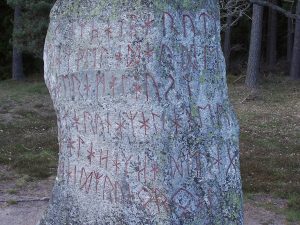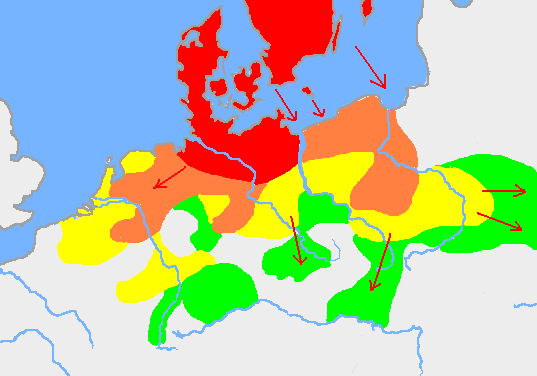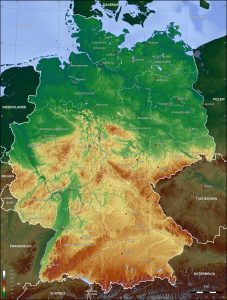1.3 Wie hat sich die deutsche Sprache entwickelt?

The West Germanic Languages
The German language is derived from the Germanic branch of the Indo-European language family, whose etymology is difficult to establish and has not yet been reconstructed with certainty.
The Germanic language family includes English, German, Dutch, Frisian, the Scandinavian languages, and Gothic. Below is a map of Europe that shows the movement of Germanic-speaking people and the expansion of early Germanic tribes. The earliest territory of Germanic-speaking peoples is shown in red.
Movement of Germanic-Speaking People

Image Description
The image depicts the geographical progression of Germanic tribes throughout Europa.
- Red: Settlements before 750 BC
- Orange: New settlements by 500 BC
- Yellow: New settlements by 250 BC
- Green: New settlements by AD 1
To learn more about the movements and migrations of the Germanic peoples visit these links:
- Germanic’s extended family (Indo-European): Indo-European languages map
- The Roman Empire and Germanic movement: Barbarian invasions
- The Germanic Groups: The wave model
High German Consonant Shift or Second Sound Shift (Zweite Lautverschiebung)
German dialects are classified as low (niederdeutsch), middle (mitteldeutsch), and high (hochdeutsch) and vary according to each region. The Zweite Lautverschiebung (in English termed High German Consonant Shift or Second Sound Shift) refers to a shift in the pronunciation of consonants that mostly affected the geographically “high” German dialects.
This shift impacted the central and southern German dialects but not (so much) the northern dialects. View the map below to better understand the regions where the low, middle and high (green) German languages were spoken.
Karte 1: Niederdeutsch (low German), Mitteldeutsch (middle German), und Hochdeutsch/Oberdeutsch (High German)

Image Description
The Zweite Lautverschiebung was considered the defining characteristic of modern German dialects. Other West Germanic languages (e.g., English, Dutch, and Scandinavian languages) did not experience this shift.
No clear consensus exists on when the Zweite Lautverschiebung occurred. Estimates are that it began between the 3rd and 5th centuries and was complete by the 8th century.
Karte 2: Topographie Deutschland

Image Description
A topographic map of Germany, displaying elevation and terrain features across the country. The northern region is relatively flat and close to sea level, bordered by the North Sea (“Nordsee”) and the Baltic Sea (“Ostsee”). The southern regions, especially Bavaria (“Bayern”), have more mountainous terrain with the Alps near the border with Austria and Switzerland. The elevation is represented by colour, with green indicating lowlands and yellow to brown shades showing higher altitudes and mountainous areas.
What does the Zweite Lautverschiebung sound like?
To answer this question, let’s take a closer look at English and German cognates (verwandte Wörter). Cognates are words in different languages that are closely related in sound and spelling. This means that they can be easily guessed because of this closeness.
Example: House (English) = Haus (German)
The key characteristic of the Zweite Lautverschiebung is that consonants with voiceless stops
- are affricated: A consonant that begins as a stop and then releases a fricative, which means that audible friction is produced by forcing the breath through a constricted or partially obstructed passage in the vocal tract
- become fricatives.
| Phonetic Symbol | English Cognates Unshifted Voiceless stop | German Cognates Shifted Affricative or Fricative | Geographical Extent Century[1] (Series of Waves) |
|
p > ff
|
|
|
4th/5th Upper and Central German |
|
p > p͡f
|
|
|
6th/7thUpper German |
|
t > ss
|
|
|
4th/5thUpper and Central German |
|
t > t͡s
|
|
|
5th/6th Upper and Central German |
|
k > x
|
|
|
4th/5thUpper and Central German |
Other Changes
| Phonetic Symbol | English Cognates | German Cognates |
Geographical Extent Century (Series of Waves) |
|
d > t
|
|
|
8th/9th Upper German |
| – | Dental Fricative | Plosive | – |
|
θ > ð > d
|
|
|
9th/10th Throughout Continental West Germanic (Except English) |
| – | /s/ before consonant in initial position | sch | – |
|
s > ʃ
|
|
|
N/A |
| – | “v” or “f“ | “b“ | – |
|
|
|
|
N/A |
 Did you know?
Did you know?
Unlike cognates, false friends (falsche Freunde) are words that are identical in form but different in meaning. Below are a few examples of English words that mean something completely different in German:
- arm (poor)
- fast (almost)
- also (so)
- bekommen (to receive)
- Gift (poison)
- Kind (child)
- Hose (pants)
- spenden (donate)
- Chef (supervisor or chef)
- Bad (bath)
- Billion (trillion)
- Brand (fire)
- herb (bitter, harsh)
- Labor (laboratory)
- Mist (dung)
- Rat (advice)
- No clear consensus exists on when the Zerite Lautverschiebung occurred. Estimates are that it began between the 3rd and 5th centuries and was complete by the 8th century. All dates given in the table are approximate. ↵

